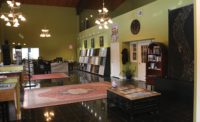Talks of re-building the library began in the 1970s, but no actions were consummated until the early 1990s. It was then that the United Nations Educational, Scientific and Cultural Organization made it a major mission to recreate one of the largest research libraries in the world. After an intense architectural competition, Snohetta of Oslo, Norway, was chosen to design the Bibliotheca Alexandrina.
With contractors Balfour Beatty and Osman Ahmed Osman, consulting firm Hamza Associates, flooring contractors Metco Contracting & Trading Co., and Laticrete Installation Systems, the project was finished 12 years later on the exact premises of the original library.
The newly built Bibliotheca Alexandrina will house 4 to 8 million volumes of books by the end of this century, and will be open holding 200,000 books, a 3,200-seat conference center, science museum, planetarium, school of information studies and a museum. It was designed to stand the test of time, while also displaying a look of architectural genius that includes a cathedral atmosphere inside and a dome-like shaped exterior.
Khaled Mekati of Metco Contracting & Trade Co. explained that Laticrete systems were essential in the library's outside reflective pond, since there was structure movement involved. A portion of the pond was built on soil, while the rest on structure columns.
"Contractors used Laticrete 4237 Latex Thin-Set Mortar Additive mixed with Laticrete 211 Crete Filler Powder to adhere over 12,000 square feet of chrome Agrob Buchtal pool tiles in the reflecting pond at the library," said Mekati. "Laticrete Sanded Grout (500 Series) plus Laticrete 1776 Grout Admix Plus were used to grout the tiles in the pool, while Laticrete 9235 Waterproofing Membrane was utilized to waterproof the entire pool substrate."
The project has already received the 2002 American Society of Civil Engineers OPAL Award and Merit Award for outstanding project.
